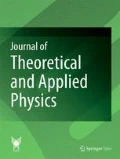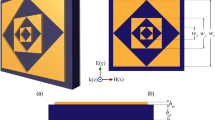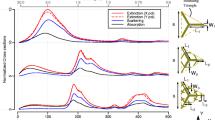Abstract
Fibonacci fractal structures have been already studied. However, more special fractal structures could be beneficial in specific applications. In this paper, we create three variations of Fibonacci fractal photonic crystals as well as original structure, including: inverse Fibonacci fractal photonic crystal, mirror symmetry Fibonacci fractal photonic crystal (MSFFPC), and finally folded Fibonacci fractal photonic crystal. The transmission spectra of these structures are simulated and analyzed. Our findings show that presented structures have their own characteristics, therefore, can be used for different applications according to required specifications. Some MSFFPC structures, for instance, could be used to develop resonant microcavities with high Q factor that can be applicable in design and construction of ultrasensitive optical sensors with very high quality factor requirements. The narrower resonance peaks and the smaller amount of interfaces lead to a higher sensitivity for this structure.
Similar content being viewed by others
Introduction
The structure of the photonic crystal (PC) has a great impact on the performance of a one-dimensional (1D) PC [1, 2]. Different structures of PCs lead to different transmission spectra, group velocity, and dispersion. These PCs can be used as optical filters [3–5], optical switches [6–8], optical logic devices [9, 10], and optical buffers [11, 12]. All of the mentioned studies are based on Euclidean geometry. Whereas the knowledge on the propagation of light waves in completely ordered and disordered structures is now rapidly improving, little is known about the behavior of optical waves in the huge intermediate regime between total order and disorder. The Fibonacci fractal photonic crystal (FFPC) structures as non-Euclidean geometrical structures have fascinating optical properties. The transmission spectrum of a Fibonacci system contains forbidden frequency regions called ‘‘pseudo band gaps’’ similar to the band gaps of a photonic crystal [13]. In the frequency regime outside these Fibonacci band gaps, the light waves are critically localized. In contrast with the fully disordered (Anderson) localized case, these critically localized states decay weaker than exponentially, most likely by a power law, and have a rich self-similar structure [14]. This makes these systems very interesting for light localization studies, as proposed by Kohmoto et al. [15]. Also the FFPCs have been successfully used to develop devices such as high-quality resonant microcavities [16] and mirrors with large omnidirectional photonic band gap (PBG) [17, 18].
The first Fibonacci sequence for electron transport studies was realized by Merlin et al. [19], which was followed by several experiments and theoretical studies on electron propagation in these systems. The experimental work on light transport in this fascinating class of structures is limited so far. Important pioneering experiments were performed by Gellermann et al. [20] who observed self-similarity in the transmission spectrum of Fibonacci dielectric multilayers and by Hattori et al. [21] who measured the Fibonacci dispersion curves. The FFPC structures have been already addressed [22]. However, these structures have a great potential to be further studied.
In this paper, therefore, we will consider three new as well as noble structures based on the Fibonacci fractal arrangements namely, the inverse Fibonacci fractal photonic crystal (IFFPC), the mirror symmetry Fibonacci fractal photonic crystal (MSFFPC), and finally the folded Fibonacci fractal photonic crystal (FFFPC) as well as the original one (FFPC), given in Xu et al. [22], which was addressed for comparison. These Fibonacci fractal structures were used in PCs and their optical characteristics were analyzed such as the transmission spectra. We also discuss the rules of the transmission peak of these fractal PCs.
In this study, an optical transmission matrix formulation [23–25] has been utilized and implemented to calculate the transmittance and reflectance through these PC structures. The descriptive definition of the Transfer-Matrix Method (TMM) [22] is as follows. For an N-layer system, the refractive index, relative permittivity, permeability, and thickness of the j layer are noted as n j , ε j , μ j , and h j , respectively. If θ j indicates the angle of incidence for a TE wave, the transmission matrix of the j layer can be expressed in Eq. (1):
In matrix M j , the meanings of the parameters are expressed in Eq. (2):
According to Eq. (1), for a multilayer dielectric, we can obtain the total transmission matrix as in Eq. (3):
Therefore, the transmittance and reflectance of the total layers can be expressed in Eqs. (4) and (5):
The transmitted and reflected power of the total layers can be expressed in Eqs. (6) and (7):
Then, the transmitted and reflected spectrum can be calculated by Eqs. (6) and (7).
In our study, the central wavelength is assumed to be λ0 = 1.5 μm and the frequency can be obtained as ω0 = 2πc/λ0, where c is the vacuum speed of light. The individual layer of the PC is designed in quarter-wave layers for which the quasi-periodicity is expected to be more effective, viz., n a d a = n b d b = λ0/4.
Fractal structure creation
As we mentioned earlier, we use different Fibonacci-base sequences to create different fractal structures to be applied to one-dimensional PCs.
FFPC is based on original Fibonacci sequence. Fibonacci sequence is a specific sequence of binary digits (or symbols from any two-letter alphabet). The Fibonacci word is formed by repeated concatenation in the same way that the Fibonacci numbers are formed by repeated addition. Let S 0 be “0” and S1 be “1”. Now, having \( S_{n} = S_{n - 1} + S_{n - 2} \) (the concatenation of the previous sequence and the one before that), we have:
IFFPC is based on inverse Fibonacci sequence. Inverse code is simply inverted binary code of a number. That is all zeroes become ones and all ones become zeroes (for example binary code \( S_{n} = 00001100 \) → inverse code \( \bar{S}_{n} = 11110011 \)). We define inverse Fibonacci sequence as \( S_{n} = S_{n - 1} + \bar{S}_{n - 2} \). So, we have:
MSFFPC is based on mirror symmetry Fibonacci sequence. Mirror symmetry is simply reflected binary code of a number (for example binary code \( S_{n} = 00001100 \) → reflected code \( \tilde{S}_{n} = 00110000 \)). We define mirror symmetry Fibonacci sequence as \( S_{n} = S_{n - 1} + \tilde{S}_{n - 2} \). So, we have:
Therefore, We have three different FFPC structures: FFPC \( S_{n} = S_{n - 1}+S_{n - 2} \), IFFPC \( S_{n} = S_{n - 1}+\bar{S}_{n - 2} \), and MSFFPC \( S_{n} = S_{n - 1}+\tilde{S}_{n - 2} \). Using A to replace “1” and B to replace “0” in the FFPC series, we can determine sequence of A and B layers in the structure. In our study, the refractive index of layer A is nA = 1.45 (SiO2) and the refractive index of layer B is nB = 2.3 (TiO2).
At the end, we offer a folded Fibonacci fractal photonic crystal (FFFPC) structure which is defined as follows:
Simulation and results
At first, we calculate the transmission spectrum of two-period (P2) FFPC with series ranging from 3 to 8 (S3–S8) for FFPC, IFFPC, and MSFFPC. Figures 1, 2, 3 show the results, respectively.
The transmission peak is defined as the one that nearly reaches the unit transmission of the forbidden band. We count the transmission peaks in Fig. 1 and draw the rule that the number of transmission peaks of the two-period FFPC is in the law of M s = Ms−1+Ms−2, which is in accordance with the structure of the FFPC where M s represents the number of transmission peaks of the two-period FFPC with the S series. This finding conforms to the previous work reported by [22].
Considering Fig. 2, we find that the number of transmission peaks of the two-period IFFPC follows the same law of FFPC. As shown in Fig. 3, the number of transmission peaks of the two-period MSFFPC is in the law of M′ s = M′s−1+M′s−2+1, where M′ s represents the number of transmission peaks of the two-period MSFFPC with the S series.
Then, we calculate the transmission spectrum of sixth series (S6) of the structure with period ranging from 2 to 7 (P2–P7). Figures 4, 5, 6 show the results, respectively.
We can see from the Figs. 4 and 5 that transmission peaks split to multiple peaks as the period P increases. If period P is even, the number of transmission peaks is in the law of M p = 3*(P − 1), otherwise, the number of transmission peaks is in the law of M p = 3*(P − 1) + 1, where Mp represents the number of transmission peaks of the sixth series FFPC and IFFPC structures with period P. As Fig. 6 shows, the number of transmission peaks is in the law of M′ p = 3*P − 1, where M′ p represents the number of transmission peaks of the sixth series MSFFPC with period P.
Now, we calculate the transmission spectrum of sixth series (S6) FFPC with Folds ranging from 2 to 7 (F2–F7). The result is shown in Fig. 7.
We can see from the Fig. 7 that transmission peaks split to multiple peaks as the fold F increases. The number of transmission peaks is in the law of M F = 2*F+1 for even F and M F = 2*F−1 for odd F, where M F represents the number of transmission peaks of the sixth series FFFPC with fold F.
Conclusion
This article introduces new variations of Fibonacci fractal structure into a 1D PC. Inverse Fibonacci fractal photonic crystal (IFFPC), mirror symmetry Fibonacci fractal photonic crystal (MSFFPC), folded Fibonacci fractal photonic crystal (FFFPC) as well as original FFPC are studied. Through theoretical analysis of the transmission spectrum it is found that the number of transmission peaks of a two-period FFPC is in the law of M s = Ms − 1+Ms − 2 in accordance with the structure of an FFPC where M s represents the number of transmission peaks of an FFPC with the S series. There is also the same rule for IFFPC. The number of transmission peaks of the two-period MSFFPC is in the law of M′ s = M′s − 1+M′s − 2+1, where M′ s represents the number of transmission peaks of the two-period MSFFPC with the S series.
When we fix the series, the transmission peaks of the sixth series FFPC and IFFPC split as the period increases. The number of transmission peaks is in the law of M p = 3*(P − 1) for even P and M p = 3*(P − 1) + 1 for odd P, where M p represents the number of transmission peaks of the sixth series FFPC and IFFPC structures with period P. When we consider the sixth series MSFFPC, the number of transmission peaks is in the law of M p = 3*P − 1. We come to the conclusion that a fractal structure can bring PC special properties in accordance with the special structure. These rules and results are of great importance for structure design of fractal PCs and a good theoretical direction to the application of fractal PCs.
Our findings show that presented structures have their own characteristics, therefore, can be used for different applications according to required specifications. For example MSFFPC S6-P2 could be used to develop high-quality resonant microcavities or narrow band pass filters with high Q factor (see Fig. 8). This structure can be applicable in design and construction of ultrasensitive optical sensors with very high quality factor requirements. The narrower resonance peaks and the smaller amount of interfaces lead to a higher sensitivity for the nonperiodic structure [26].
References
Joannopoulos, J.D., Johnson, S.G., Winn, J.N., Meade, R.D.: Photonic crystals: molding the flow of light. Princeton Univ. Press, Princeton (2007)
Villa-Villa, F., Gaspar-Armenta, J.A., Mendoza-Suarez, A.: Surface modes in one-dimensional photonic crystals that include left-handed materials. J. Electromagn. Waves Appl. 21, 485–499 (2007)
Zheng, C., Tian, H., Li, C., Ji, Y.: Tunable frequency and angular photonic crystal filter. Proc. SPIE 6781, 678117 (2007)
Kanamori, Y., Matsuyama, N., Hane, K.: Resonant-wavelength tuning of a pitch-variable 1-D photonic crystal filter at telecom frequencies. IEEE Photon. Technol. Lett. 20, 1136–1138 (2008)
Nemec, H., Duvillaret, L., Garet, F.: Thermally tunable filter for terahertz range based on a one-dimensional photonic crystal with a defect. J. Appl. Phys. 96, 4072–4075 (2004)
Zyryanov, V.Y., Gunyakov, V.A., Myslivets, S.A., Arkhipkin, V.G., Shabanov, V.F.: Electro-optical switching in a one-dimensional photonic crystal. Mol. Cryst. Liq. Cryst. 488, 1563–5287 (2008)
Krauss, T.: Ultracompact optical switch based on photonic crystal waveguides. In: Optical Fiber Communication Conference, OSA Technical Digest (CD) (Optical Society of America, 2009), paper OWC2 (2009)
Gunyakov, V.A., Zyryanov, V.Y., Myslivets, S.A., Arkhipkin, V.G., Shabanov, V.F.: Electrically controllable optical switch based on one-dimensional photonic crystal. In: Proceedings of IEEE Fourth International Conference on Advanced Optoelectronics and Lasers (IEEE, 2009), pp. 186–188 (2009)
Andalib, P., Granpayeh, N.: All-optical ultracompact photonic crystal and gate based on nonlinear ring resonators. J. Opt. Soc. Am. B 26, 10–16 (2009)
Zou, H., Liang, G.-Q., Wang, H.-Z.: Efficient all-optical dual-channel switches, logic gates, half-adder, and halfsubtracter in a one-dimensional photonic hetero-structure. J. Opt. Soc. Am. B 25, 351–360 (2008)
Baba, T.: Slow light in photonic crystals. Nat. Photonics 2, 465–473 (2008)
Di Falco, A., O’Faolain, L., Krauss, T.F.: Dispersion control and slow light in slotted photonic crystal waveguides. Appl. Phys. Lett. 92, 083501 (2008)
Capaz, R.B., Koiller, B., de Queiroz, S.L.A.: Gap states and localization properties of one-dimensional Fibonacci quasicrystals. Phys. Rev. B 42, 6402 (1990)
Fujiwara, T., Kohmoto, M., Tokihiro, T.: Multifractal wave functions on a Fibonacci lattice. Phys. Rev. B 40, 7413 (1989)
Kohmoto, M., Sutherland, B., Iguchi, K.: Localization of optics: Quasiperiodic media. Phys. Rev. Lett. 58, 2436 (1987)
Escorcia-Garcia, J., Mora-Ramos, M.E.: Study of optical propagation in hybrid periodic/quasiregular structures based on porous silicon. PIERS Online 5(2), 167–170 (2009)
Han, P., Wang, H.: Criterion of omnidirectional reflection in a one-dimensional photonic heterostructure. J. Opt. Soc. Am. B 22(7), 1571–1575 (2005)
Srivastava, R., Pati, S., Ojha, S.P.: Enhancement of omnidirectional reflection in photonic crystal heterostructure. Prog. Electromagn. Res. B 1, 197–208 (2008)
Merlin, R., Bajema, K., Clarke, R., Juang, F.Y., Bhattacharya, P.K.: Quasiperiodic GaAs/AlAs Heterostructures. Phys. Rev. Lett. 55, 1768 (1985)
Gellermann, W., Kohmoto, M., Sutherland, B., Taylor, P.C.: Localization of light waves in Fibonacci dielectric multilayers. Phys. Rev. Lett. 72, 633 (1994)
Hattori, T., Tsurumachi, N., Kawato, S., Nakatsuka, H.: Photonic dispersion relation in a one-dimensional quasicrystal. Phys. Rev. B 50, 4220 (1994)
Xu, P., Tian, H.P., Ji, Y.F.: One-dimensional fractal photonic crystal and its characteristics. J. Opt. Soc. Am. B/Vol. 27(4), 640–647 (2010)
Zi, J., Wan, J., Zhang, C.: Large frequency range of negligible transmission in one-dimensional photonic quantum well structures. Appl. Phys. Lett. 73, 2084–2086 (1998)
Jiang, M.P., Jiang, X.F., Shen, X.M., Xu, D.W., Shi, D.F.: Study on the polarization property of 1-D photonic crystal. Chin. J. Quantum Electron. 22, 612–616 (2005)
Puppin, R.: Surface polaritons of a left-handed medium. Phys. Lett. A 277, 61–64 (2000)
Moretti, L., Rea, I., de Stefano, L., Rendina, I.: Periodic versus aperiodic: enhancing the sensitivity of porous silicon based optical sensors. Appl. Phys. Lett. 90, 191112 (2007)
Acknowledgments
Intellectual and financial support of this work by the Science & Research Branch of Islamic Azad University (SRBIAU) and Sheykh Bahaee Research Complex (SBRC) is gratefully acknowledged.
Author information
Authors and Affiliations
Corresponding author
Rights and permissions
Open Access This article is distributed under the terms of the Creative Commons Attribution License which permits any use, distribution, and reproduction in any medium, provided the original author(s) and the source are credited.
About this article
Cite this article
Tavakoli, M., Jalili, Y.S. One-dimensional Fibonacci fractal photonic crystals and their optical characteristics. J Theor Appl Phys 8, 113 (2014). https://doi.org/10.1007/s40094-014-0113-0
Received:
Accepted:
Published:
DOI: https://doi.org/10.1007/s40094-014-0113-0












